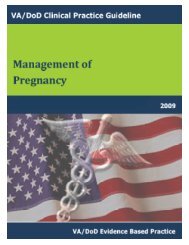DM Full Guideline (2010) - VA/DoD Clinical Practice Guidelines Home
DM Full Guideline (2010) - VA/DoD Clinical Practice Guidelines Home
DM Full Guideline (2010) - VA/DoD Clinical Practice Guidelines Home
You also want an ePaper? Increase the reach of your titles
YUMPU automatically turns print PDFs into web optimized ePapers that Google loves.
Version 4.0<br />
<strong>VA</strong>/<strong>DoD</strong> <strong>Clinical</strong> <strong>Practice</strong> <strong>Guideline</strong><br />
for the Management of Diabetes Mellitus<br />
J-5. Glycemic Control for Hospitalized Patients<br />
BACKGROUND<br />
Hyperglycemia during hospitalization is associated with adverse outcomes independent of diabetes. Importantly,<br />
glucose lowering interventions have been shown to reduce morbidity and mortality in some critically ill populations.<br />
However, establishing evidence-based guidelines for inpatient glycemic control is challenging due to the fact that<br />
trials have produced discrepant findings and in many cases have had methodologic problems limiting the<br />
conclusions that can be made. Overall, the evidence supports the treatment of hyperglycemia during hospitalization,<br />
in both patients with and without a diagnosis of diabetes. Evidence to support “tight” glycemic control (80-110<br />
mg/dl) remains insufficient. Although there are few studies examining the benefits of more moderate glucose<br />
lowering, the overall body of literature supports treating hyperglycemia to glucose levels < 180 mg/dl. Most of the<br />
controversies have centered on the ideal and exact glucose target for hospitalized patients, as well as which<br />
populations would derive benefit from glucose lowering interventions. However, a growing body of evidence from<br />
hospitals throughout the country indicates that more basic aspects of diabetes and glucose management during<br />
hospitalization are often not addressed. The following recommendations are intended for hospitalized patients with<br />
hyperglycemia and/or diabetes mellitus (<strong>DM</strong>) but are not intended for those with diabetic ketoacidosis (DKA),<br />
hyperosmolar hyperglycemic nonketotic syndrome (HHNS) or pregnancy.<br />
RECOMMENDATIONS<br />
1. In patients with known <strong>DM</strong>, it is reasonable to document the <strong>DM</strong> diagnosis in the medical record. Because<br />
of the potential harm from omission of insulin in patients with type 1 <strong>DM</strong>, it is suggested that the type of<br />
<strong>DM</strong> also be documented. [I]<br />
2. In order to identify potentially harmful hyperglycemia and hypoglycemia, blood glucose monitoring may<br />
be ordered in hospitalized patients with diagnosed <strong>DM</strong> and/or hyperglycemia (BG > 180 mg/dl) on<br />
admission. There is no evidence to support a given frequency of monitoring. Therefore, the frequency of<br />
monitoring should be based upon clinical judgment taking into account the management of diabetes, the<br />
reason for admission, and the stability of the patient. [I]<br />
3. Due to safety concerns related to potential adverse events with oral anti-hyperglycemic medications, it is<br />
prudent to thoughtfully review these agents in the majority of hospitalized patients. It may be reasonable to<br />
continue oral agents in patients who are medically stable and have good glycemic control on oral agents at<br />
home. [I]<br />
4. For patients with <strong>DM</strong> and/or hyperglycemia who are not medically stable or who are poorly controlled with<br />
oral anti-hyperglycemic medications at home, initiating insulin therapy should be considered. It is<br />
appropriate to continue pre-hospitalization insulin regimens, but reasonable to reduce the dose in order to<br />
minimize the risk of hypoglycemia. In the ICU, continuous intravenous insulin infusion is recommended.<br />
Scheduled subcutaneous insulin is appropriate in the non-ICU setting and may include a long-acting basal<br />
insulin as well as a nutritional insulin for those eating discrete meals or receiving enteral nutrition. A<br />
supplementary correction (sliding) scale is also recommended but correction scale insulin regimens as sole<br />
therapy are discouraged. [B]<br />
5. Insulin should be adjusted to maintain a BG < 180 mg/dl with the goal of achieving a mean glucose around<br />
140 mg/dl. Evidence is lacking to support a lower limit of target blood glucose but based on a recent trial<br />
suggesting that blood glucose < 110 mg/dl may be harmful, we do not recommend blood glucose levels <<br />
110 mg/dl. [A]<br />
6. Insulin therapy should be guided by local protocols and preferably “dynamic” protocols that account for<br />
varied and changing insulin requirements. A nurse-driven protocol for the treatment of hypoglycemia is<br />
highly recommended to ensure prompt and effective correction of hypoglycemia. [I]<br />
7. To minimize the risk of hypoglycemia and severe hyperglycemia after discharge it is reasonable to provide<br />
hospitalized patients who have <strong>DM</strong> and knowledge deficits, or patients with newly discovered<br />
hyperglycemia, basic education in “survival skills”. [I]<br />
8. Patients who experienced hyperglycemia during hospitalization but who are not known to have <strong>DM</strong> should<br />
be re-evaluated for <strong>DM</strong> after recovery and discharge. [B]<br />
Module G: Glycemic Control Page 68
















